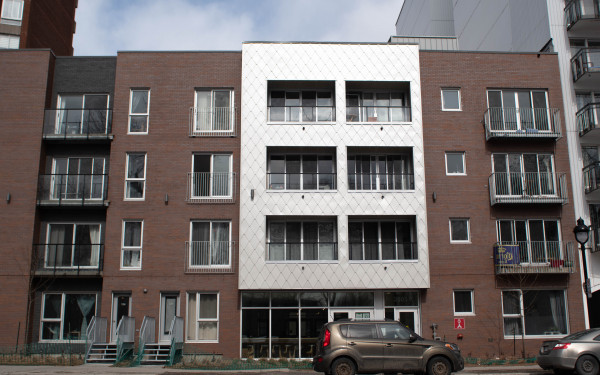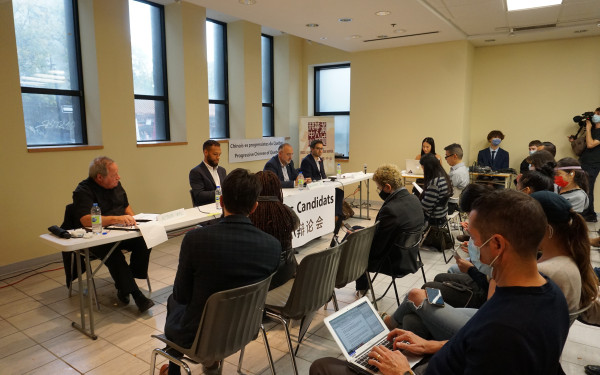Losing a Heritage Building, Gaining Student Residences
Redpath Mansion Torn Down After 28 Years of Debate Over Historic Value
Last Monday, Michael Sochaczevski got some good news.
A building owned by his family had been deemed asbestos-free by the Commission de la santé et de la sécurité du travail. Its demolition could go ahead as planned, clearing the land for a private student residence intended to house Concordia and McGill University students at the cost of $1,000 per month.
Normally this wouldn’t be a controversial story. New development projects spring up all the time in Montreal, and the conversion of existing buildings into student housing is common in the city. As early as this past January two private companies purchased the Holiday Inn on Sherbrooke St. for just this purpose.
But the house that Sochaczevski’s family finally got the go-ahead to tear down is not a typical property—it’s the Redpath Mansion, built in 1886 and meant to house the daughter of John Redpath and her husband.
Redpath founded Quebec’s first sugar refinery and was instrumental in the construction of the Lachine Canal and many of McGill’s early buildings.
On Wednesday, the mansion was torn down, ending an almost 30-year struggle between developers, the mayor’s office, heritage groups and concerned citizens.
28 Years Later
Each year, the non-profit organization Heritage Montreal releases a list of threatened sites and those under observation. This year, like every year since 2008, the Redpath Mansion was listed as threatened.
“[The list is] mostly made to point at issues. We use the buildings and sites as examples, but in general we’re talking of issues that touch a number of sites, not just the ones that are shown,” said Dinu Bumbaru, Heritage Montreal’s policy director.
“With the 10 sites, we’d like to display the kind of panorama of the heritage in Montreal and the issues that are attached to its preservation.”
In the Redpath Mansion’s case, its presence on the list indicates Heritage Montreal’s concern with what Bumbaru calls the “weakness and the lack of determination of the public authorities.”
“They’ve been closing their eyes for almost 30 years in that situation,” he said. “Whenever a neighbour in that area, or in many of the neighbourhoods in Montreal, applies for a permit to repair their balcony, which is relatively minor, they get scrutinized […], but then letting a building rot for 30 years, nobody bothers you.”
Sochaczevski sees things differently, especially when it comes to whether or not the Redpath Mansion qualifies as a heritage building given that it has never been classified as such by any governing body.
_900_597_90.jpg)
“There was no heritage, there is no heritage, and it was never classified anywhere because there is no heritage to it, other than it was a property owned by Redpath. That was it,” he said.
Sochaczevski’s relationship with Heritage Montreal began back in the mid-1980s when his family purchased the mansion and the land it was on. Since then, there have been a series of struggles between both parties as the Sochaczevski family tried to do what they bought the land for—develop it with the intention of building condos—and Heritage Montreal tried to protect it.
In 1986, when the Sochaczevski family began to swing the wrecking ball, Heritage Montreal brought forward an injunction, and the demolition was halted after nearly half of the building had been destroyed.
“The deal [was that] they wanted to save the façade. This was 28 years ago, when the façade maybe could have been saved, reasonably,” Sochaczevski said. “Not that it had any heritage, not that it was important to us in any way, but to be good citizens or whatever, we made a deal that was good for everybody.”
The deal involved adding two additional floors onto the design the Sochaczevskis had proposed and the equivalent height, being four floors, on the adjacent property on de la Montagne St.
_900_597_90.jpg)
Things seemed to be moving forward, but when the economy slowed in the 1990s, construction ground to a halt and nothing was erected on the property, nor was anything torn down.
In 1995, however, Montreal’s economy had improved enough that the Sochaczevski family reevaluated the property to figure out what to do with it.
The mansion’s demolition was again blocked by Heritage Montreal following arbitration, because the non-profit felt that the decision to issue a demolition permit required greater consultation.
“For whatever reason—mostly because, I think, we had a bad lawyer—[Heritage Montreal] won and the project got stopped,” Sochaczevski said.
In 2000, Sochaczevski, who is the publisher of community newspaper The Suburban, says he was approached by then-mayor Pierre Bourque, who, he says, told him to “get rid of this piece of crap.” Former mayor Gérald Tremblay denounced Bourque’s failure to protect the building while running for mayor. Like Bourque, Sochaczevski says Tremblay later approached him saying, “I’ve got this mess on the street, let’s do something.”
All of the projects Sochaczevski tried to push through were the subjects of complaints, and up until last week the building at 3457 du Musée Ave. stood as it had since 1986 when its demolition began.
“A lot of money to do this, a lot of money to do this,” Sochaczevski said, flipping through the various designs that had been proposed and subsequently rejected due to complaints from different parties.
_900_597_90.jpg)
Brick by Brick
The obvious question is why nothing was done to preserve the building’s fragile state between 1986 and the present, but for Sochaczevski the answer is straightforward.
“This building had no reason to ever be saved, and then couldn’t be saved. At the beginning we didn’t take care of it because we didn’t know how, we didn’t know what, we didn’t know it was important to take care of,” he said.
For Anne-Marie Sigouin, the heritage and design critic for municipal opposition party Projet Montréal and member of the city’s Culture, Heritage and Sports Committee, the mayor’s office should have done more.
“Heritage Montreal stopped [the demolition], and then [the developers] came back in 2011,” Sigouin said. “There were many avenues that the city could have looked into to preserve the house and they didn’t, so it was really a lack of having the heritage at heart, really.”
2_900_600_90.jpg)
Bumbaru agreed, pointing to engineers’ reports as evidence that the building did not have to be torn down.
“In 2010, the engineer, who is a respected engineer who worked on parliament buildings in Ottawa, and many of the historic buildings in Montreal, said the structure was valid, could be rehabilitated, it was solid,” he said.
“The report [released this February by the same engineer] said there’s nothing to add to the 2010 report. So, when Mayor Coderre says the house is in such a bad shape that it’s a tragic security threat and so on, this is complacency,” he added.
The engineer reports produced in 2010 and 2014 differ from the information that Sochaczevski was operating on. He says a 2005 survey they had commissioned found that the bricks themselves could not be saved without heavily investing.
“By the time we were discussing preserving the piece of crap in the state it was, it was 2005. Twenty years after [buying the building], we actually sent engineers. The engineers said, ‘If you take this apart, brick by brick, and numbered them, 70 per cent of the bricks would crumble,’” Sochaczevski said.
Sochaczevski stresses that he’s never violated building laws.
“We only did things we were allowed to do, we always asked permission first, and when we got told to stop—even though it cost us a lot of money—we stopped the minute we were told,” he said.
The Lowest Common Denominator
Now that the building has been razed, the land can be cleared for the planned student residences. It seems as though Sochaczevski will get to realize this 28-year-old goal of erecting a new building on the site, but he still wishes it were a bit different.
“Is the dorm project a good project for that area? No. It’s the lowest common denominator. It’s what Montreal, what Quebec, what we are forcing on this place,” he said.
“Montreal was a great city. [In] 1967, we were on top of the world. This was the city of the future. Today? Because everybody gets to say and to object and to bother and to stop, we only do the lowest common denominator.”
Sigouin and Bumbaru also wish it were different—for other reasons.
“It’s really difficult to accept that there was nothing done to protect [the mansion],” said Sigouin. “It’s clear that it’s sending the wrong message—that if you own a building and you just let it go like that for years and years and then you ask to demolish it and build something else and the city lets you do that, it’s completely the wrong message to send.
“We’ll keep putting pressure on the current administration so that this doesn’t constitute a dangerous precedent for other owners, negligent owners,” she continued.
“Demolition by neglect is a real issue,” Bumbaru said. “We’re concerned that the Redpath case, how it was handled by the current administration, is sending a message that they’re open for business to bring back demolition by neglect to Montreal.”
Requests by The Link for an interview with Montreal’s urban heritage department were declined.
Sochaczevski emphasized that he has nothing against heritage preservation, but stressed that it should be reserved for buildings deemed to have historical importance —something he feels the Redpath Mansion lacked.
“Some of the buildings [Heritage Montreal] talks about preserving have true heritage. Some buildings, I would help preserve too,” he said.
1_900_600_90.jpg)
However, he added, “There’s no reason to preserve nothing.”
Bumbaru says new policies could help avoid situations like this in the future.
“We’d like to push for the city of Montreal to adopt a real and transparent policy with respect to abandoned buildings,” he said. “Obviously they’re lacking resources and political will, but we can help them generate that, because they have the powers of the law. […] The politicians in this case have been very lazy and complacent.”
Sigouin pointed to existing regulations on the maintenance of private buildings like the Redpath Mansion, noting that a lack of resources becomes an issue and the regulation becomes hard to enforce.
“It’s the boroughs who are supposed to apply the regulation, but they often lack the resources to do so. The city of Montreal’s heritage division also is a resource for the city’s elected [officials]. We can ask them to produce documentation and studies, and analysis on private houses,” she said, adding that the Comité consultatif d’urbanisme of each borough is supposed to serve as a way of reviewing architectural projects “so at that stage we can pose certain conditions for the projects to go ahead.”
“Certainly we see by all these different citizen mobilizations that heritage is something that Montrealers have at heart, and the elected officials need to wake up and see that it’s important,” she said.
“It’s part of the soul of our city that’s slowly dying if we don’t do anything.”
Photos Erin Sparks and Shaun Michaud

3_900_600_90.jpg)
_600_832_s.png)


2_900_600_90_600_375_90_s_c1.jpg)

